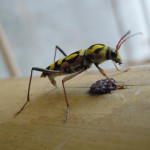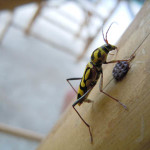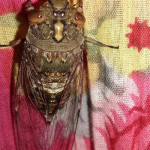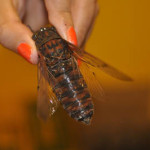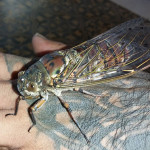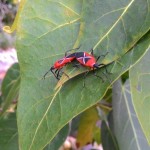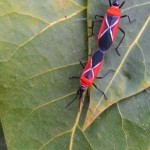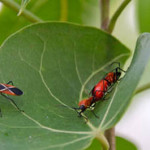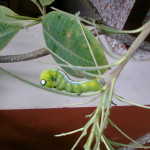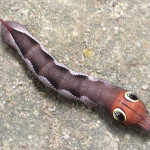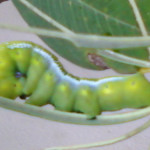Batocera rufomaculata
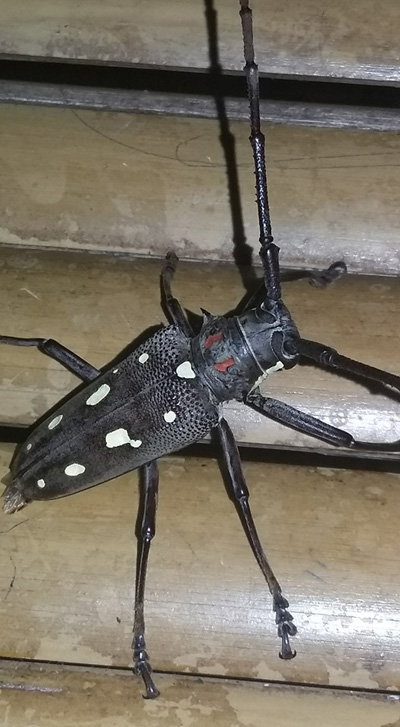
Image Copyright Supotch White
Observed: November 2015
Observed By: Supotch White
Minor controversy surrounds this sighting. It looks like a longhorn beetle but has been identified as its close cousin Batocera rufomaculata. When we get the help of an expert entomologist (hint, hint) we can iron out little issues like this – in the meantime we present a great photo of a pretty cool beetle.
Batocera rufomaculata Wikipedia
Artena Convergens
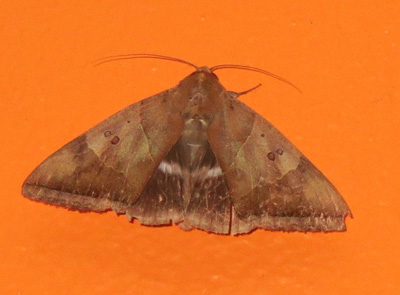
Image: Dave Hinchliffe
Observed: November 2015
Observed By: Dave Hinchliffe
Information is a little scarce on Artena convergens. Wikipedia is unusually reticent and it doesn’t seem to have been given a common name, poor thing. It’s quite a pretty moth as well, subtle colours, but attractive. Anyway it’s a moth of the Noctuidae family that has been spotted on Koh Chang, more specifically on my kitchen wall.
Artena Convergens Wikipedia
Blue-Banded Bee (anthophorid genus amegilla)
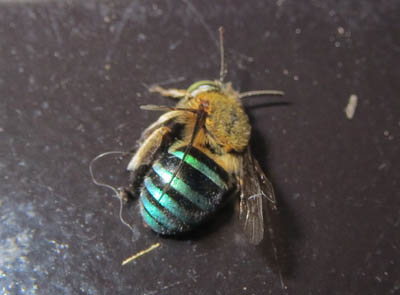
Image: Dave Hinchliffe
Last Observed: November 2015
Observed By: Dave Hinchliffe
The blue-banded be is a bee, with blue bands. In fact it’s a dead ringer for the yellow and black honey bee that you’re probably more familiar with except for the colour variation. And it doesn’t make honey.
It is a vital insect to agriculture and also to natural plant pollination – particularly in Australia – because it practises a very efficient form of pollination know as buzz pollination.
The blue-banded bee can sting but is less agressive than other species of bee and they are solitary dwellers.
Blue-banded bee Wikipedia
Bamboo Loghorn Beetle (Chlorophous Annularis)
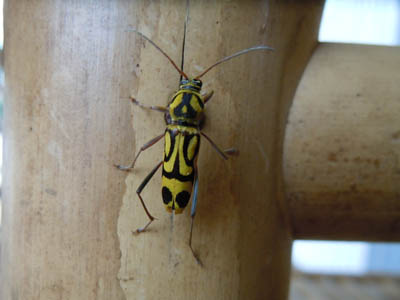
Image Copyright Tijl Adriaen
Last Observed: November 2015
Observed By: Tijl Adriaen
Chlorophorus annularis, a.k.a. the Bamboo Longhorn Beetle, is a species of beetle in the family Cerambycidae. It has an elaborate yellow and black patterned shell.
Image Copyright Tijl Adriaen
Image Copyright Tijl Adriaen
Cicada (Platylomia radha)
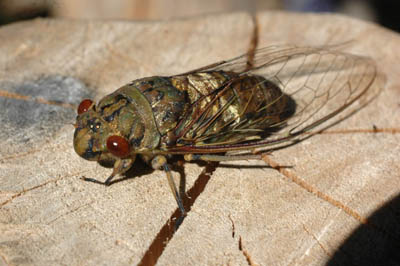
Image Copyright David Newman
Last Observed: December 2015
Observed By: David Newman, Jean-Piere Odet, Supotch White
Cicadas are a widespread insect species that are most common in the tropics. You will seldom see them but if you’re anywhere near one, especially around sunset, you’ll know.
They make a high pitched, screeching sound that can be most disconcerting. They do this using a specially developed exoskeletal structure called a tymbal which they vibrate rapidly with cacaphonic results.
If they fly into your room you can easily pick them up by gently pinching together their wings and set them, and your ears, free.
Platyloma Wikipedia
Image Copyright Jean-Pierre Odet
Image Copyright David Newman
Image Copyright Supotch White
Cotton stainers (dysdercus suturellus)
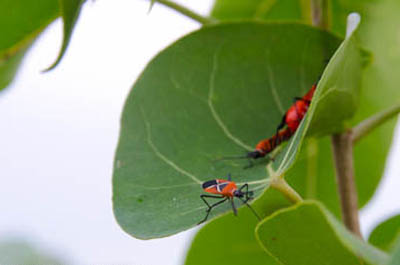
Image Copyright David Vinot
Last Observed: February 2015
Observed By: David Vinot
The Cotton Stainer is a small insect that comes from the family Pyrrhocoridae. They are charectirised by simple but striking shell markings in a similar fashion to the man-faced shield bug.
Pyrrhocoridae Wikipedia
Image Copyright Teerasak Thomas Suamcheepmasau
Image Copyright Teerasak Thomas Suamcheepmasau
Image Copyright David Vinot
Oleander Hawk Moth (Daphnis nerii)
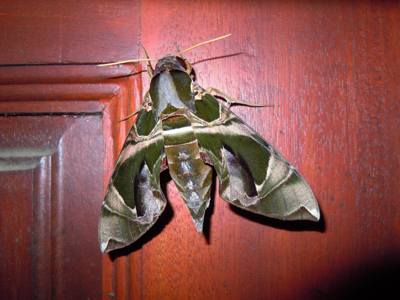
Image Copyright Tijl Adriaen
Last Observed: November 2015
Observed By: Tijl Adriaen, Dave Hinchliffe
The Oleander Hawk Moth is striking as a caterpillar and has a beautiful adult form as well.
The caterpillar has very large false eye colours to mislead predators.
The moth feeds largely on the highly toxic oleander plant, to which it is immune. When it can’t feed Oleander it thrives on plants from a family called Dogbane, you’d have to assume they were toxic too.
Daphnis Nerii Wikipedia
Image Copyright Dave Hinchliffe
Image Copyright Dave Hinchliffe
Image Copyright Dave Hinchliffe
Dasychira Horsfieldi
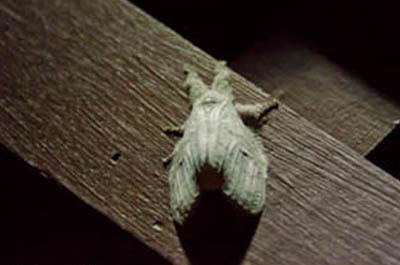
Image Copyright David Vinot
Last Observed: February 2015
Observed By: David Vinot
Dasychira Horsfieldi is a small moth named after a chap called Horsfield. And that’s about all we can tell you.
Handmaiden Moth(Syntomoides imaon)
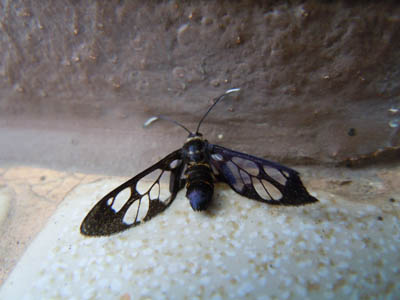
Image Copyright Tijl Adriaen
Last Observed: November 2015, Koh Chang
Observed By: Tijl Adiaen
The Handmaiden moth is a small but striking insect with two yellow bands on a black body. It is the wings, however that are the moth’s most arresting feature. On afirst glance they apear to be full of holes but this is because the clear wing sections are covered by a hyaline patch.
Handmaiden Moth Wikipedia
Great Eggfly(Hypolimnas bolina)
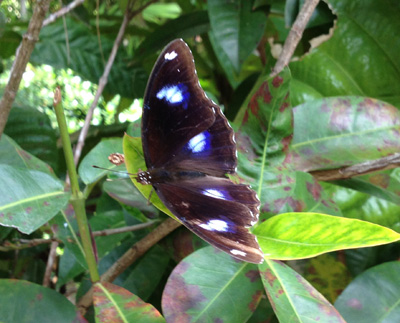 Last Observed: February 2015, Koh Chang
Last Observed: February 2015, Koh Chang
Observed By: David Vinot
The Great Eggfly as you will notice is actually a butterfly. It is a member of the Nymphalid family of butterflies and in BNew Zealand it goes under the far more alluring name of the Blue Moon Butterfly.
Great Eggfly Wikipedia





